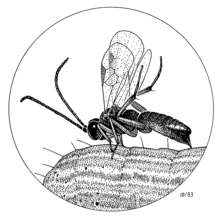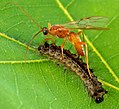Braconidae
| Braconidae Temporal range:
| |
|---|---|

| |
| Atanycolus sp. | |
| Scientific classification | |
| Domain: | Eukaryota |
| Kingdom: | Animalia |
| Phylum: | Arthropoda |
| Class: | Insecta |
| Order: | Hymenoptera |
| Superfamily: | Ichneumonoidea |
| Family: | Braconidae Latreille , 1829
|
| Subfamilies | |
|
47, see text | |
| Synonyms | |
|
Stenophasmidae Benoit, 1949 | |
The Braconidae are a family of parasitoid wasps. After the closely related Ichneumonidae, braconids make up the second-largest family in the order Hymenoptera, with about 17,000 recognized species and many thousands more undescribed.[1] One analysis estimated a total between 30,000 and 50,000, and another provided a narrower estimate between 42,000 and 43,000 species.[1]
Classification
The Braconidae are currently divided into about 47 subfamilies and over 1000 genera,
These fall into two major groups, informally called the cyclostomes and noncyclostomes. In cyclostome braconids, the
Subfamilies
- Acampsohelconinae
- Agathidinae
- Alysiinae
- Amicrocentrinae
- Aphidiinae
- Apozyginae
- Betylobraconinae
- Blacinae
- Brachistinae
- Braconinae
- Cardiochilinae
- Cenocoeliinae
- Charmontinae
- Cheloninae
- Dirrhopinae
- Doryctinae
- Ecnomiinae
- Euphorinae
- Exothecinae
- Gnamptodontinae
- Helconinae
- Histeromerinae
- Homolobinae
- Hormiinae
- Ichneutinae
- Khoikhoiiinae
- Lysiterminae
- Macrocentrinae
- Masoninae
- Maxfischeriinae
- Mendesellinae
- Mesostoinae
- Meteorideinae
- Meteorinae
- Microgastrinae
- Microtypinae
- Miracinae
- Neoneurinae
- Opiinae
- Orgilinae
- Pambolinae
- Pselaphaninae
- †Protorhyssalinae
- Rhysipolinae
- Rhyssalinae
- Rogadinae
- †Seneciobraconinae
- Sigalphinae
- Telengaiinae
- Trachypetinae
- Vaepellinae
- Xiphozelinae
- Ypsistocerinae


Morphology
The morphological variation among braconids is notable. They are often black-brown (sometimes with reddish markings), though some species exhibit striking coloration and patterns, being parts of
Females often have long
Life history

The larvae of most braconids are internal or external
Examples of hosts
Thousands of species of insects are used as hosts by braconid wasps. A few notable examples are detailed here.
Some species of braconids are parasitoids of Ostrinia furnacalis (the Asian corn borer, a lepidopteran moth known for being a pest of maize in East Asia), the African sugarcane borer (a moth commonly found in sub-Saharan Africa),[9] the butterfly Danaus chrysippus in Ghana,[10] and Liriomyza trifolii (the American serpentine leafminer) and Manduca quinquemaculata (the tomato hornworm) in North America.[11] Braconids often will prey on fruit fly larvae like Anastrepha suspensa as well.[12]
These viruses suppress the immune system and allow the parasitoid to grow inside the host undetected. The exact function and evolutionary history of these viruses are unknown. Sequences of polydnavirus genes show the possibility that venom-like proteins are expressed inside the host caterpillar. Through the evolutionary history of being used by the wasps, these viruses apparently have become so modified, they appear unlike any other known viruses today. Because of this highly modified system of host immunosuppression, a high level of parasitoid-host specificity is not surprising.
Evolutionary history
The family seems to date from early Cretaceous (provided that Eobracon is properly assigned to this family). It underwent extensive diversification from mid or late Cretaceous to early Cenozoic, correlating with the radiation of flowering plants and associated insect herbivores, the main hosts of braconids.
Differentiation from Ichneumonidae


Braconids are distinguished from their
Other characteristics
The species
At least some braconids appear to be very resistant to
Gallery
-
Cotesia melanoscela
-
Aleiodes indiscretus ovipositing in its host, a gypsy moth caterpillar
-
Apanteles sp. cocoons on Papilio demoleus
-
Braconid wasp empty cocoons
-
Cotesia adult
References
- ^ S2CID 86775770.
- ^ Beyarslan, A. and M. Aydogdu. (2013). Additions to the rare species of Braconidae fauna (Hymenoptera: Braconidae) from Turkey. Mun Ent Zool 8(1) 369-74.
- ^
Wharton, R. M. (2000). "Can braconid classification be restructured to facilitate portrayal of relationships?". In Austin, A. D.; Dowton, M. (eds.). Hymenoptera: evolution, biodiversity, and biological control. 4th. Vol. International Hymenopterists Conference. Collingwood, Victoria, Australia: Commonwealth Scientific and Industrial Research Organisation (CSIRO). pp. 143–153. ISBN 978-0-643-06610-6.
- S2CID 52986629.
- ISSN 0033-2615– via Santa Clara University Scholar Commons.
- S2CID 85057439.
- ISSN 0022-2933.
- ^ Mahr, S. (February 1998). "Know Your Friends: Aphidius Wasps". Midwest Biological Control News Online. University of Wisconsin–Madison. Archived from the original on 2 January 2013. Retrieved 25 March 2013.
- .
- ISSN 0024-4082.
- ^ Gray, Betty. "Beneficial insects in the garden: #04 Braconid Wasp on Hornworm (Cotesia congregatus)". aggie-horticulture.tamu.edu. Retrieved 2017-11-14.
- OCLC 9311697.
- Greenwood Press.
- S2CID 6538583.
- ^ Sharkey, M. J. Family Braconidae. pp. 362–94 In: Goulet, H. and J. Huber (eds.) Hymenoptera of the World, an Identification Guide to Families. Agriculture Canada Research Branch Monograph No. 1894E. 1993.
- ^ Hall, M. Scientists recruit wasps for war on terror. USA Today December 26, 2005. Accessed June 19, 2012.
- ^ Cockroaches and radiation. ABC Science. February 23, 2006.
Further reading
- Achterberg, C. van (1990): Illustrated key to the subfamilies of the Holarctic Braconidae (Hymenoptera: Ichneumonoidea) Zoologische Mededelingen Vol. 64 p. 1–20 PDF
- Achterberg, C. van (1993): Illustrated key to the subfamilies of the Braconidae (Hymenoptera: Ichneumonoidea) Zoologische Verhandelingen Vol. 283 p. 1–189 PDF
External links
- Braconidae. Tree of Life.
- Braconidae. Encyclopedia of Life.
- Sharkey, M. J. (2004). Synopsis of the Agathidinae (Hymenoptera: Braconidae) of America north of Mexico. Proceedings of the Russian Entomological Society 75(1), 134–52.
- Ghahari, H., et al. Bibliography of the family Braconidae (Hymenoptera: Ichneumonoidea) (1964–2003). NNM Technical Bulletin 8. 2006. ISSN 1387-0211
- van Achterberg, C. and C. O'Toole. (1993). Annotated catalogue of the types of Braconidae (Hymenoptera) in the Oxford University Museum. Zoologische Verhandelingen 287(1) 1–43.
- Species profiles from the University of Florida Institute of Food and Agricultural Sciences:






